
We recommend you visit the interactive version. The text to the right is provided for printing purposes.
|


|
|
Learning
from the past
The
August 2007 collapse of Minnesota's I-35W bridge over the Mississippi
River killed 13 people. Tragic as it was, that accident and what we learn from
it will help scientists and engineers foresee and act on structural problems
and prevent failures of other spans. In this slide show, see how lessons learned from past collapses have helped improve bridge
safety, and how "smart" sensing technology is already aiding the
monitoring and maintenance of bridges both new and old.—Rachel
VanCott
|
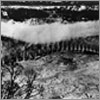

|
|
Honeymoon Bridge
Collapsed
1938
The Honeymoon Bridge in Niagara Falls, Ontario, Canada was one of the world's largest arch-bridge spans. But its life ended
abruptly in the winter
of 1938,
when a rush of
water clogged with ice flooded the Niagara River, severely damaging the
bridge's supports and causing it to plummet into the gorge. (Sensing
collapse was imminent, officials had closed the bridge, so there were no
casualties.) The bridge's successor, optimistically named the Rainbow
Bridge, features elevated supports that keep the span's lowest point a
full 50 feet above the water level, 28 feet higher than the Honeymoon's
lowest part.
|
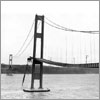

|
|
Tacoma Narrows Bridge
Collapsed
1940
After
it opened in July 1940, the Tacoma Narrows Bridge in Washington State earned
the nickname "Galloping Gertie," because its flexible design
allowed the roadway to literally ripple in the wind. But when gusts reaching
over 40 mph began buffeting the bridge on November 7 of that year, its motion
suddenly changed. Instead of rippling, the road started to twist. Concrete
cracked, cables frayed, and, after only four
months of service, the
span collapsed. In response to the failure, which fortunately killed no
one, engineers stiffened
the supportive posts of California's Golden Gate Bridge and decreased the
flexibility of later suspension-bridge designs.
|
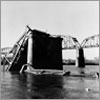

|
|
Silver Bridge
Collapsed
1967
West Virginia's Silver Bridge was the first suspension bridge to hang from a linked chain of steel bars instead of standard wire cables. It was nearly impossible for inspectors to reach the steel chain, however. Even if they'd been able to, they didn't have the means to detect the crack that formed within one of the links. On December 15, 1967, that link—and the chain it was an integral part of—snapped, plunging the bridge into the Ohio River and killing 46 commuters. Today, engineers are developing sonar sensors that may be able to detect such cracks long before they cause trouble. With such devices, inspectors can send sound waves into steel and analyze the returning waves for changes in pitch, which can signal hidden cracks and other defects.
|
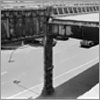

|
|
West
Side Highway
Collapsed
1973
According
to inspection reports in the early 1970s, New York's West Side Highway
had become too small to accommodate the 130,000 motorists who traveled it each
day, and it was also falling apart. Yet little had been done when, on December
16, 1973, as a contractor was en route to conduct a routine repair of the
roadway, part of the bridge buckled and fell. The collapse took the
contractor's loaded dump truck down with it.
(Fortunately, no one was hurt.) Modern sensors can measure roadway strain and
alert experts, who can use such sensor readings, for example, to adjust a
bridge or highway's weight restrictions as necessary before any collapse
occurs.
|
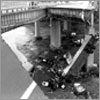

|
|
Mianus
River Bridge
Collapsed
1983
According to one federal safety inspector, the Mianus River Bridge in Connecticut let out an eerie "wail" just before breaking apart on June 28, 1983. The undetected fracture of a connecting pin concealed beneath the roadway caused the collapse, which killed three. In response to the disaster, state officials established a system of remote bridge monitoring. Using sensors that measure tilt, strain, temperature, and movement, inspectors can constantly monitor a bridge's behavior and anticipate problems. The system is currently in use on several Connecticut bridges.
|
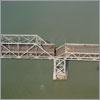

|
|
San Francisco-Oakland Bay Bridge
Collapsed 1989
On October 17, 1989, the
Loma Prieta earthquake, registering 7.1 on the Richter scale, struck San
Francisco. The quake caused the eastbound span of this double-decked bridge to
shift, shearing several connective bolts. One end of a 50-foot section of the top deck crashed to the lower
level, killing one motorist who was
unable to stop before driving into the gap. After the earthquake, California Department
of Transportation engineers reexamined roadways and strengthened or rebuilt
older structures across the state.
|
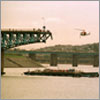

|
|
Songsu Bridge
Collapsed 1994
The Songsu Bridge, which spans the Han River in Seoul,
South Korea, fell
without warning on October 21, 1994, killing 32. Investigation revealed that
inadequate welding on the steel supports caused an overloaded section of the
bridge to give way. The collapse prompted
city officials to inspect all of the bridges along the river. Recently, several Asian governments have mandated the implementation of structural-health monitoring as part of new bridge construction.
|
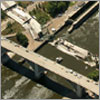

|
|
I-35W
Mississippi River Bridge
Collapsed
2007
As
of this writing (July 2008), officials have yet to formally announce the cause
or causes of the August 2007 rush-hour collapse in Minnesota. But a preliminary
report released in January 2008 revealed that strain on the
structure's gusset plates, which held the bridge's support beams in
place, contributed to
the collapse. The gusset plates were part of a "non-redundant" design. If any major component of
the bridge failed, the structure was bound to collapse. The design of the
replacement bridge features multiple failsafes—no single part of
the structure alone bears the bridge's weight. The new bridge is also
being fitted with hundreds of sensors to track temperature, motion, strain, and
chemical wear.
|
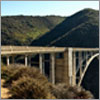

|
|
Bixby
Creek Bridge
Along
the Pacific coast of California at Big Sur, the Bixby Creek Bridge stands as a
model reminder of how to seek and correct structural problems early on, long
before they trigger a potential disaster. When inspectors declared the span
functionally obsolete in 1997, engineers from the California Department of
Transportation set out to save it. Among other repairs, they strengthened the
tall columns beneath the bridge by encasing them in white "jackets"
of epoxy and carbon nanofibers, a composite material that is both stronger and
lighter than steel. So far, more than a thousand California bridges have
undergone similar renovations as part of a plan to help the bridges withstand
natural disasters. 
|
|
|




